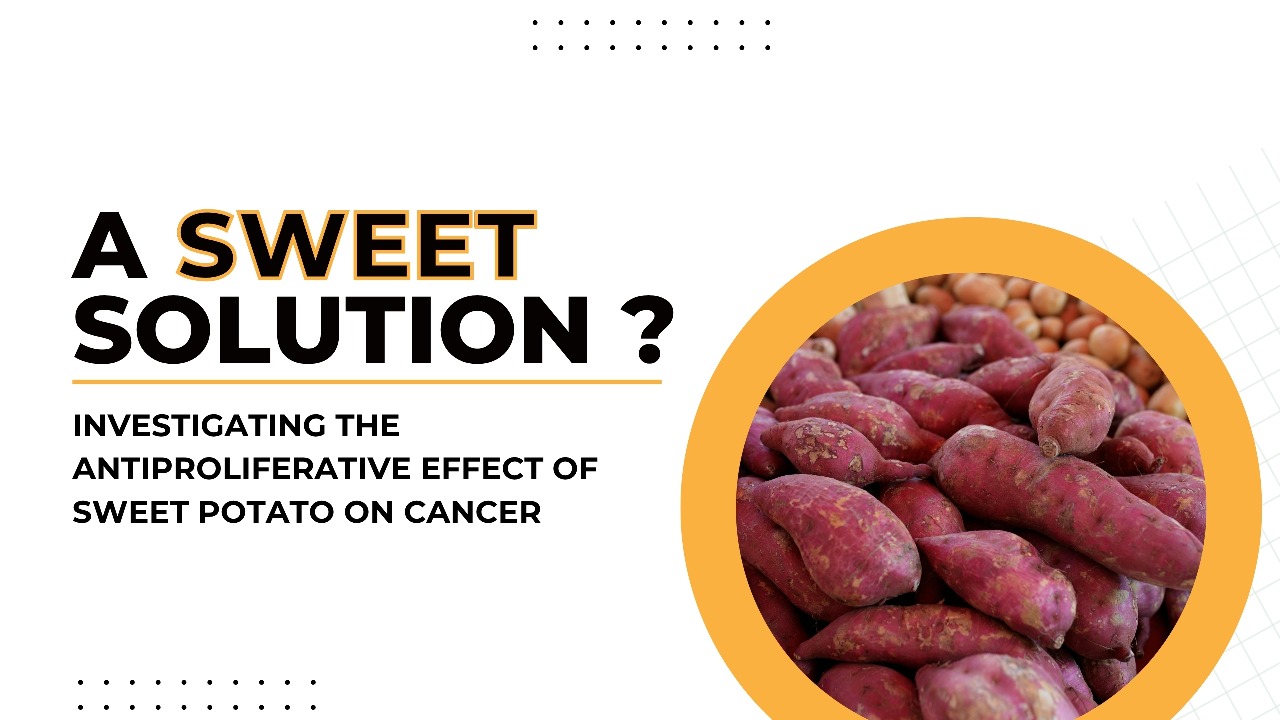In the quest for natural solutions to combat cancer, researchers have increasingly turned to the untapped potential of everyday foods. Among these, sweetpotato (Ipomoea batatas), a staple crop revered for its nutritional richness, has emerged as a surprising powerhouse. While its vibrant tubers often steal the spotlight, a groundbreaking study published in ‘BMC Complementary Medicine and Therapies’(2025) by Nwosisi et al. reveals that sweetpotato leaves and stems may hold the key toJorge to unlocking potent anticancer properties. This blog dives into the study’s findings, highlighting the antiproliferative effects of sweetpotato leaf and stem extracts on breast and lung cancer cell lines, and explores why this underutilized vegetable could revolutionize functional nutrition.
Sweetpotato: More Than Just a Root Vegetable
Sweetpotato, a nutrient-dense crop native to tropical America but now grown in over 100 countries, is celebrated for its tuberous roots, packed with dietary fiber, vitamins, and minerals. However, the leaves and stems—often discarded as waste—contain a treasure trove of bioactive compounds like polyphenols, anthocyanins, flavonoids, and phenolic acids. These phytochemicals are known for their antioxidant, anti-inflammatory, and potential anticancer properties, making sweetpotato leaves a promising candidate for medicinal applications.
The study by Nwosisi et al., conducted at Tennessee State University, focused on methanolic extracts from the leaves of the All Purple cultivar and the leaves/stems of the Carolina Ruby cultivar, tested against human lung (A549) and breast (BT549) cancer cell lines. The results are nothing short of remarkable, demonstrating significant dose-dependent inhibition of cancer cell growth, with implications for both dietary and pharmaceutical interventions.
The Study: A Deep Dive into Anticancer Effects
Using the Alamar Blue assay, a highly sensitive method to measure cell viability, the researchers evaluated the cytotoxicity of sweetpotato extracts. Here’s what they found:
– All Purple Leaf Extracts: These extracts, derived from a purple-fleshed sweetpotato cultivar, exhibited potent anticancer activity. The half-maximal effective concentration (EC50) values were 0.013 µg/µl for A549 lung cancer cells and an impressive 0.002 µg/µl for BT549 breast cancer cells. At the highest tested concentration (0.00313 µg/µl), the extracts inhibited BT549 cell growth by 75.65% compared to the control, showcasing a stronger effect on breast cancer cells than lung cancer cells.
– Carolina Ruby Leaf/Stem Extracts: The orange-fleshed Carolina Ruby cultivar’s leaf and stem extracts proved even more effective against lung cancer cells, with an EC50 value of 0.0014 µg/µl and a striking 96.07% inhibition of A549 cell growth at 0.0056 µg/µl—surpassing the positive control, tamoxifen, a standard chemotherapy drug.
These findings suggest that the bioactive compounds in sweetpotato leaves and stems, particularly anthocyanins and polyphenols, may play a critical role in suppressing cancer cell proliferation. Unlike tamoxifen, which caused significant cell death (96.63% and 92.42% inhibition in A549 and BT549 cells, respectively), the sweetpotato extracts showed selective cytotoxicity, with minimal effects at lower concentrations, indicating potential safety for non-cancerous cells.
Why Sweetpotato Leaves? The Science of Bioactive Compounds
The anticancer potential of sweetpotato leaves is largely attributed to their rich phytochemical profile. Purple-fleshed cultivars, like All Purple, are particularly high in anthocyanins, which have been shown to inhibit cancer cell growth by inducing apoptosis (programmed cell death) and disrupting cell cycle progression. Phenolic acids, such as caffeoylquinic acids, and flavonoids like quercetin, also contribute to these effects by reducing oxidative stress and inflammation—key drivers of cancer development.
Carolina Ruby’s leaf and stem extracts, with their unique blend of bioactive compounds, demonstrated exceptional efficacy against lung cancer cells. This could be due to synergistic interactions between polyphenols and other phytochemicals, a phenomenon that warrants further exploration. Previous studies, such as those by Kurata et al. (2007) and Vishnu et al. (2019), have confirmed that sweetpotato leaf compounds inhibit various cancer cell lines, including stomach, colon, and prostate cancers, reinforcing the broader therapeutic potential of this plant.
A Nutritional Powerhouse with Global Impact
Globally, sweetpotato is a vital crop, with 95% of its production occurring in developing nations. Yet, its leaves are underutilized, often discarded or used as animal feed. In regions like Africa, Asia, and the Caribbean, sweetpotato leaves are consumed as leafy greens, but in the United States, they remain largely overlooked. This study highlights an opportunity to transform this agricultural byproduct into a valuable resource for cancer prevention and treatment.
From a nutritional perspective, sweetpotato leaves are a rich source of antioxidants, vitamins (C, B, and β-carotene), and minerals (iron, calcium, zinc). These nutrients not only support general health but also combat oxidative stress, a key factor in cancer pathogenesis. Incorporating sweetpotato leaves into diets could serve as a cost-effective, accessible strategy for reducing cancer risk, particularly in regions with high cancer incidence, such as the United States, where lung and breast cancers remain leading causes of mortality.
The Future of Sweetpotato in Cancer Research
While the study’s results are promising, they represent a starting point. Further research is needed to:
- Identify Specific Bioactive Compounds: Pinpointing the exact molecules responsible for the anticancer effects could lead to targeted therapies or functional food products.
- Elucidate Mechanisms of Action: Understanding how these extracts induce apoptosis or affect cell cycle progression will enhance their therapeutic application.
- Conduct Clinical Studies: Translating in vitro findings to human trials is critical to validate efficacy and safety.
- Explore Synergistic Effects: Investigating how different phytochemicals interact could optimize their anticancer potential.
Additionally, the study underscores the need for safety evaluations, as toxicity data for sweetpotato leaves are limited. However, the low toxicity observed at lower extract concentrations suggests a favorable safety profile, aligning with the traditional use of sweetpotato in herbal medicine across cultures.
From Farm to Pharmacy: A Call to Action
The findings of Nwosisi et al. challenge us to rethink the value of sweetpotato leaves and stems. By harnessing their bioactive compounds, we could develop novel anticancer drugs or functional foods that complement existing treatments like chemotherapy. For consumers, adding sweetpotato leaves to meals—whether in salads, smoothies, or stir-fries—could offer a delicious and nutritious way to bolster health.
As researchers, we must continue to explore the pharmacological potential of this “superfood.” Collaborative efforts between agricultural scientists, nutritionists, and pharmacologists could pave the way for innovative products, from dietary supplements to standardized extracts. For communities, especially in the Southeastern United States where sweetpotato is a major crop, promoting the consumption of its leaves could enhance public health while supporting sustainable agriculture.
Conclusion
The humble sweetpotato, long cherished for its roots, is revealing its leaves and stems as potent allies in the fight against cancer. The study by Nwosisi et al. provides compelling evidence of their antiproliferative effects on lung and breast cancer cells, driven by a symphony of bioactive compounds. As we stand at the intersection of nutrition and medicine, sweetpotato leaves offer a promising path toward affordable, natural cancer prevention strategies. Let’s embrace this overlooked gem and unlock its full potential for a healthier future.
Reference
Nwosisi, S., Nandwani, D., & Myles, E. L. (2025). Antiproliferative potential of sweetpotato in breast (BT549) and lung (A549) cancer cell lines. *BMC Complementary Medicine and Therapies*, 25(79). https://doi.org/10.1186/s12906-025-04770-9
Note: This blog is intended for informational purposes and does not constitute medical advice. Always consult a healthcare professional before making dietary or medical changes.
Written by -Dr Sathyachandran K


